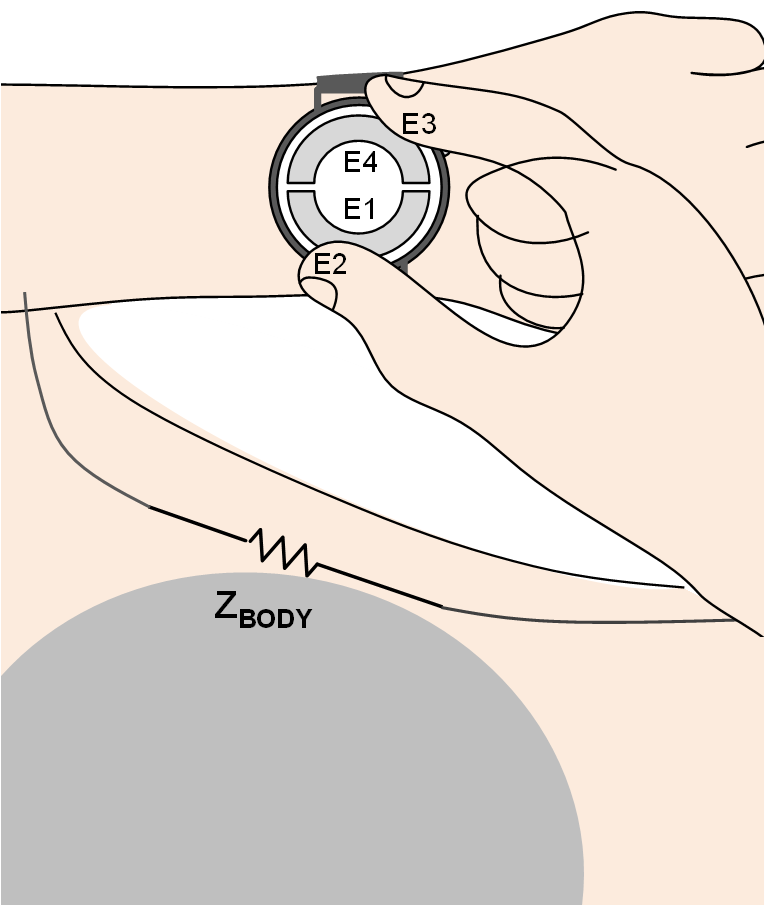SBAA562 November 2022
1 Body Composition Measurement (BCM) for Wearables
Application
Body Composition Measurement (BCM) using Bio-Impedance Analysis (BIA) refers to the estimation of various components that make up the body composition (water, muscle, fat, and so forth) by measuring the electrical impedance between one or more segments of the human body. Water is the main conductor of electrical current in the body, and BCM utilizes the fact that fatty tissue has a low % of water, whereas muscle has a high % of water. The basis of a BIA device is the injection of an excitation current into the body at one or more frequencies using a pair of electrodes, and sensing of voltage using another pair of electrodes. Single-frequency (SF) BIA uses a single frequency, most commonly 50 kHz. Multiple-frequency (MF) BIA uses multiple frequencies (for example, 5 kHz to 250 kHz). The biggest challenge of accurate BIA on a wearable device is the high and time-varying contact impedances resulting from small form-factor electrodes. Figure 1-1 shows an illustration of BIA measurement on a smartwatch.
 Figure 1-1 BIA Measurement on a
Smartwatch
Figure 1-1 BIA Measurement on a
SmartwatchFigure 1-2 shows the electrical network model of a BIA system. ZBODY refers to the body impedance being measured. The impedances marked as ZE1..ZE4 model the contact impedance between the electrode and the user. The challenge of accurate body impedance measurement on a wrist-worn wearable device largely stems from the fact that the magnitude of ZE1..ZE4 can be similar to, or higher than ZBODY. The capacitances CE1..CE4 model the electrode capacitance to ground.
The AFE4500 is an analog front end from TI that is designed for BIA measurements on a wearable device.
AFE4500 Overview
- Interface: SPI™, I2C interfaces: Selectable by pin
- Package: 3-mm × 2.6-mm DSBGA, 0.4-mm pitch
- Supplies: RX: 1.7 V–3.6 V, IO: 1.7-RX_SUP
- First in, first out (FIFO) with 256-sample depth
- Integrated LDO
- Low-noise and accurate estimation of body impedance with calibration for high and mismatched electrode contact impedance.
- Flexible configuration of electrodes, excitation frequency, measurement range.
- Third-party solutions: Electrode Design, Clinical Study, Algorithms (for example, Hydration).
Figure 1-3 shows the reference schematic of the AFE4500 used in Body Composition Measurement (BCM) on wearables.
Figure 1-4 shows the BIA signal chain in the AFE4500. A sine-wave excitation at a programmable frequency is generated using a Direct Digital Synthesis (DDS) engine. The received signal is I-Q demodulated in analog to recover the amplitude and phase of the impedance. A calibration engine cycles through multiple configurations, and the measured values are combined to get an accurate estimate of bio-impedance.
Table 1-1 lists the specifications for a wearable BCM system.
| System Specifications | Requirement | AFE4500 | Comments |
|---|---|---|---|
| Number of BIA electrodes | 4 | 4 | Multiplexers to choose any electrode as excitation or sense |
| Excitation frequency | About 50 kHz | 5 kHz – 250 kHz | Programmable frequency |
| Bio-impedance range | About 1 kΩ | 100 Ω – 3 kΩ | Range extendable with excitation voltage programmability |
| Impedance noise | Low | 40 mΩpp | Integrated over a noise bandwidth of 0.1 Hz to 4 Hz for a single measurement configuration |
| Impedance accuracy | < 2% | 1% | In the presence of several kΩ of contact impedance |